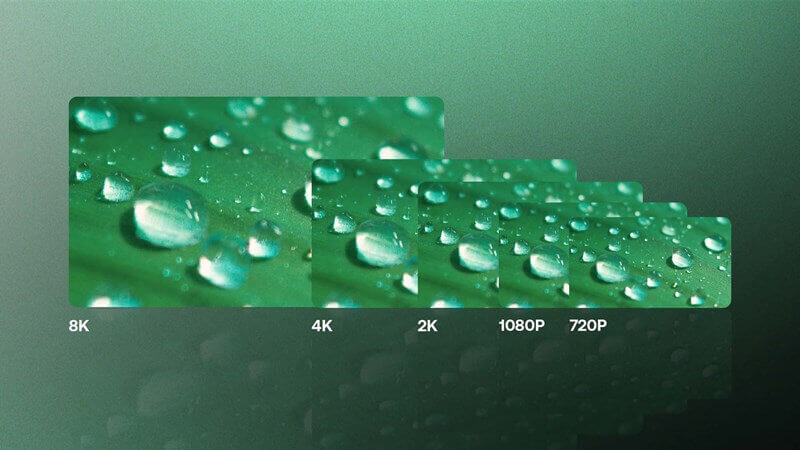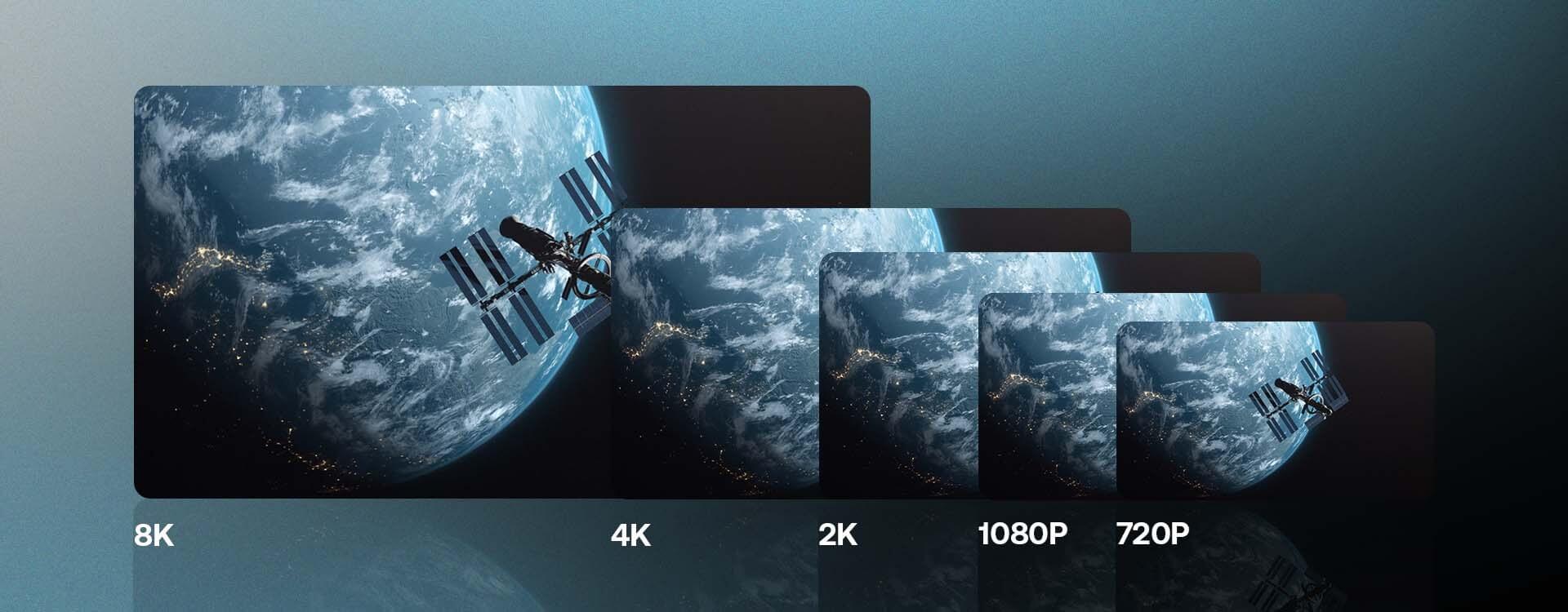Highlights
Table of Contents
Explore article topics
By now anyone with a television has heard of 4K video, but what really is the difference between 720p resolution size and 8K resolution size and which one should you choose? It all comes down to understanding video resolution. In fact, you will need to master it as a filmmaker, content creator or even a YouTuber. In this article, we will define resolution and clue you in on the best video sizes for common platforms.
Video Resolution
What does resolution mean? Put simply, resolution is the size of an image measured in pixels. Pixels are the dots that make up a frame. Standard aspect ratio for TV and computers is 16:9, so we are talking about the number of pixels in those dimensions. The more pixels or dots, the more data a frame contains. More data equals higher quality, a clearer picture and more detail. Understanding resolution is key because it will help you choose the best recording settings as well as export settings for your given output, whether it be social media or the silver screen. Learning how to choose a video camera is also vital as you begin understanding resolution definition.
It’s important to comprehend well the terms that apply to output as you want your videos to be the best combination of quality and speed.
SD Video
Standard definition video is 1280 x 720 pixels, although it’s not considered so standard anymore. HD video replaced 720 resolution size years ago, and 4K is right on its tail. However, for social media output, SD can still be the right output, especially if you’re formatting just for handheld mobile devices and want to prioritize speed of loading and play! However, SD will usually be too small and low quality for computer screens, so avoid it unless your output is limited to just phones.
HD Video
High definition video is less so than in the past because larger, more detailed frame sizes such as 4K are now common. So what is HD resolution size? HD resolution is 1920 x 1080. HD video dimensions are measured in a 16:9 aspect ratio–1920 pixels wide by 1080 pixels high.
4K Video
So what is 4K? It is said to be a video frame at least 4,000 pixels wide, though technically 4K is just under that at 3840 x 2160 pixels. 4K video has multiple dimensions and also includes larger sizes. So you see, how many pixels in 4K video varies, whereas HD is always the same. 4K video is also marketed as UHD (ultra-high-definition television).

8K Video
You will rarely need to output in 8K (7680 x 4320 pixels), However, this extremely high-quality format offers more pixel information for reframing without any loss of pixels. You can find 8K stock footage on Artgrid.
Here’s a video resolution chart for quick reference:
| Resolution | Pixel Size | Aspect Ratio | Term |
| SD (Standard Definition) | 640 x 480 | 4:3 | 480p |
| HD (High Definition) | 1280 x 720 | 16:9 | 720p |
| Full HD | 1920 x 1080 | 16:9 | 1080p |
| 2K | 2048 x 1152 | 1:1.77 | N/A |
| UHD | 3840 x 2160 | 16:9 | 4K |
| DCI 4K | 4096 x 2160 | 1:1.9 | 4K |
Bitrate
What is bitrate? Bitrate measures how much data is recorded and then read on playback. Not to be confused with bitrate is frame rate, which is how many frames per second (fps) are recorded in a single frame–24, 30, 60, 120, etc. Higher frame rates usually require higher bitrates, which can increase the size of your files.
Get unlimited royalty-free 4K footage
What is aspect ratio?
Aspect ratio is the width and height of an image in relation to one another. For example, dividing 1920 by 1080 gives you 16/9. This aspect ratio is also referred to as “widescreen” and is currently the most common in digital output.
Social media export settings
When exporting videos for social media, you’ll need to get the following settings right:
- Aspect ratio
- Resolution
- Bitrate (less important)
Here’s a quick reference of aspect ratios and their corresponding resolutions for most social media platforms:
- Landscape – 16:9 – 1280 x 720 pixels
- Portrait – 9:16 – 1280 x 720 pixels
- Square – 1:1 – minimum of 600 x 600 pixels
As for bitrate, that can be a bit more complicated. Twitter’s minimum recommended video bitrate is 5000Kbps, whereas if you’re live streaming a video to Facebook, the bitrate should be 3000 to 6000Kbps. However, as for YouTube export settings, at 1080p and 30fps in HDR, you’ll want 10Mbps. For SDR, you should reduce your bitrate to 8Mbps, and for a 1080p HDR video with a higher frame rate, you’ll need to increase the bitrate to 12Mbps.
Instagram compresses even 4K video down to standard compression at 640 x 360 resolution and 3mbps. Boo! But that doesn’t mean you shouldn’t still record 4K video, especially if you want to zoom or crop in on your frame and then export at 1080p resolution. Video format for Instagram can be tricky because there are so many options for posting now: Stories, Posts, Reels, IGTV… read up on our blog to become an expert.
Because a phone in vertical orientation displays an aspect ratio of 9:16 (rather than “widescreen” 16:9), you have to take into account how your video will be viewed. If your video is intended to be viewed at 16:9, you’ll want to export it in that aspect ratio with the minimum video resolution for your intended platform.
By now you know how to upload a video to Facebook, but again what are the best Facebook export settings? Remember that Facebook accepts feed videos of up to 4GB that are in fixed frame rates (no more than 30fps), have a progressive scan and H.264 compression.
And finally, there are TikTok export settings. To create the best-looking TikTok videos, shoot in vertical video dimensions and export in the same dimensions.
Summary
In conclusion, the best video resolution for each platform varies, but having this new basic understanding of each aspect ratio and frame size will help! You will learn common resolutions the more videos you create, edit and export. So, get out there and shoot! Try out different video resolutions and then, of course, all the technicalities will make more sense.
Jessica Peterson is a travel and documentary filmmaker with a background in journalism and marketing. She runs Purple Noon Productions from sunny Los Angeles. She has 20 years of experience producing content in 114 cities and 25 countries. In 2016, she directed and produced her own documentary about her then-home of Guam. Her clients include CNN, United Airlines, Southwest Airlines, Matador Network, and Tastemade.
Share this article
Did you find this article useful?
Related Posts
- By Mike Russell
- 15 MIN READ
- By Jonathan Mateer
- 7 MIN READ
Latest Posts
- 25 Apr
- By Josh Edwards
- 4 MIN READ
